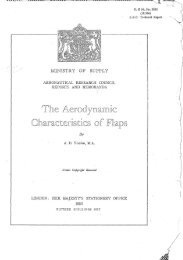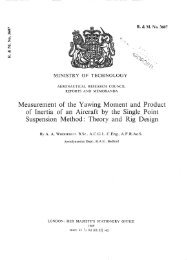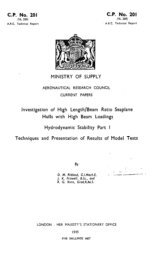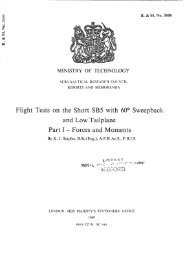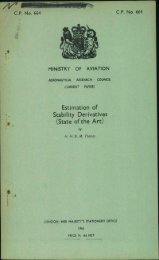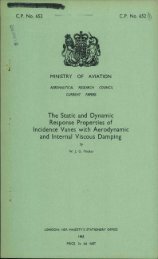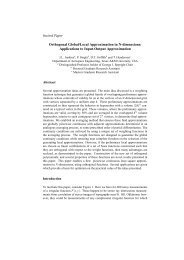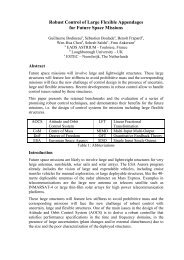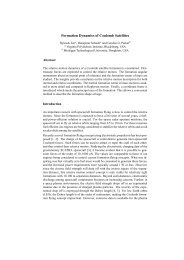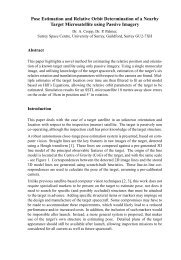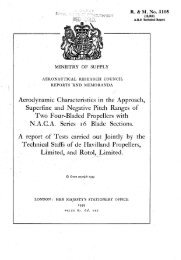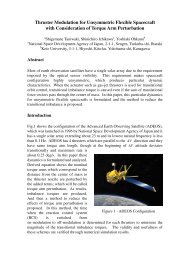A Survey of Unsteady Hypersonic Flow Problems
A Survey of Unsteady Hypersonic Flow Problems
A Survey of Unsteady Hypersonic Flow Problems
Create successful ePaper yourself
Turn your PDF publications into a flip-book with our unique Google optimized e-Paper software.
- 32 -<br />
indication <strong>of</strong> their reliability, even though results <strong>of</strong> their use under steady<br />
conditions cannot be conclusive evidence <strong>of</strong> their value when the flow is<br />
unstoaay.<br />
In Figs. 10 and 11 third order piston theory predictions for the<br />
pressure distribution on a blconvex parabolic arc section aer<strong>of</strong>oil are shown<br />
compared with the distribution from a characteristics solution, which should<br />
be accurate for the inviscid flow. For a two-dimensional section the correction<br />
for boundary layer growth should be straightforward and need not be considered<br />
in this comparison. At M = 3'5, in Fig. 10, the agreement is quite olose,<br />
though third-order piston values are consistently low; at M = IO, in Fig. 11,<br />
the errors are much greater. The departures from the characteristics result are<br />
greatest in the regions <strong>of</strong> the nose and trailing edge over which MC > 1 (8 is<br />
the surface slope). The error in the prediction <strong>of</strong> the oentre <strong>of</strong> pressure for<br />
a single surface would be quite large, but this does not necessarily mean that<br />
the oentre <strong>of</strong> pressure for the section is similarly in error, since this depends<br />
on the increment <strong>of</strong> pressure difference with incidence and not the overall distribution.<br />
Calculations by Newtonian impact theory are compared with characteristic<br />
results for the same bioonvex section at M=lO and 02 for zero incidence, and<br />
at M = 10 for an incidence <strong>of</strong> 19~9~ in Figs. 11, 12 and 13. Results are shown<br />
for equation (6) and for this expression modified to gave the oorreot pressure<br />
at the leading edge. The unmodified equation always gives values <strong>of</strong> pressure<br />
that are considerably lower than the accurate ,values. The modified equation is<br />
inadequate at M = 10, (1 = O" (Fig. 11); even at M = m it is considerably<br />
in error beyond the one third chord point (Fig. 12). For the section at an<br />
incidence <strong>of</strong> 19*9O, the theory is being tested under very favourable conditions,<br />
since there should be only a thin shook layer over the lower surface <strong>of</strong> the<br />
section. Even for this ease (Fig. 13), there are appreolable errors in the<br />
pressure distribution given by the modified expression.<br />
Results for two-dimensional shook-expansion theory are given in<br />
Figs. 14 and 15. In Fig. 14, pressure distributions on the same 1% aer<strong>of</strong>oil<br />
section as before are given for the characteristics calculation, for the shock<br />
expansion method, and for a simplified version <strong>of</strong> the shook expansion method<br />
applicable to slender bodies at high Mach number (this slender aer<strong>of</strong>oil method<br />
corresponds to the expressions used to derive equation (2.49)). There is close<br />
agreement <strong>of</strong> the methods. In Fig. 15, the effect <strong>of</strong> real gas thermodynamics<br />
on the pressure distributions are shown. When oalorlc and thermal imperfections<br />
<strong>of</strong> the gas are fully considered in the shock expansion method, the results differ<br />
very little from the characteristics result, consequently the characteristics<br />
results have not been included in Fig. 15. The results from the slender aer<strong>of</strong>oil<br />
method use an average value <strong>of</strong> y throughout the field. Above an incidence <strong>of</strong><br />
about IO' it is clear that the departures from perfect gas behaviour become<br />
significant, especially for the, slender aer<strong>of</strong>oil method.<br />
Figs. 16 and 17 illustrate the use <strong>of</strong> generalised shock expansion<br />
theory on an ogivalbody <strong>of</strong> revolution. In Fig. 16 comparzon is made with both<br />
characteristics results and with experiment. At adequate values <strong>of</strong> M6 = Md/8<br />
agreement with the characteristics results is seen to be gocd, and Fig. 17 shows<br />
that the agreement with experiment is also good if account is taken <strong>of</strong> the<br />
boundary layer. (In Ref. 29 it is argued on physical grounds that, provided the<br />
boundary layer flow is largely hypersonic, and the conditions governing the<br />
application <strong>of</strong> two-dimensional shock expansion theory to a three-dimensional<br />
body are satisfied; the boundary layer flow along geodesics can also be<br />
calculated using two-dimensional relationships). In Figs. 19-23 results are<br />
given for the application <strong>of</strong> shock expansion theory to more OomPlex slender<br />
bodies26 ./



